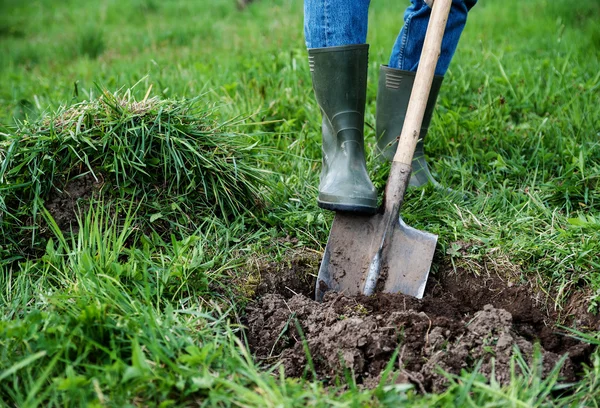Mastering the Use of a Digging Shovel: A Comprehensive Guide
A digging shovel, with its simple yet effective design, is a tool that has been a steadfast companion to gardeners, landscapers, builders, and outdoor enthusiasts for centuries. Its enduring popularity stems from its ability to tackle a wide array of tasks with precision and ease. From garden beds to construction sites, a digging shovel proves its worth time and again through its versatile applications. We will also provide a step-by-step guide on how to use a digging shovel effectively for any of your varied needs.
If you need help finding a digging shovel for any of the versatile applications listed below, see our product review article here.
Unearthing Versatility: The Many Applications of a Digging Shovel
Gardening Glory
One of the primary domains where a digging shovel shines is gardening. Whether you’re a seasoned horticulturist or a weekend warrior, a digging shovel is an indispensable tool. It aids in the preparation of garden beds by turning and loosening soil, creating the optimal environment for seeds and plants to flourish. Whether you’re planting ornamental flowers or cultivating vegetables, the digging shovel plays a pivotal role in establishing the foundation for a successful garden.
Landscaping Mastery
In the realm of landscaping, a digging shovel becomes an artist’s brush, shaping the canvas of outdoor spaces. It’s used to create defined borders, dig trenches for irrigation systems, and sculpt the terrain to craft breathtaking landscapes. With its ability to move soil and create contours, the digging shovel empowers landscapers to mold nature into aesthetically pleasing and functional designs.
Building Foundations
When it comes to construction, the importance of a digging shovel cannot be overstated. It’s the first tool that breaks ground, whether for a home’s foundation, a utility trench, or a retaining wall. Its sturdy blade cuts through soil, gravel, and even harder materials, making it an essential partner in construction projects of all scales.
Earthmoving Expertise
A digging shovel isn’t limited to small-scale tasks. Its capabilities extend to larger earthmoving projects as well. When combined with manpower, it’s a reliable tool for shifting large amounts of earth and materials, making it an essential component in site preparation, land clearing, and excavation work.
Snow and Ice Control
When winter arrives, the digging shovel transforms into a snow-clearing hero. Its ability to lift and move snow efficiently makes it a go-to tool for clearing driveways, walkways, and sidewalks. The same qualities that make it effective for digging in soil also allow it to scoop away compacted snow and ice.
Utility and Farm Work
On farms and utility sites, digging shovels prove their worth in a variety of ways. From digging post holes for fences to creating ditches for drainage systems, they play a crucial role in maintaining the functionality and aesthetics of these spaces.
Outdoor Adventure
Even in recreational settings, a digging shovel finds its place. Campers and outdoor enthusiasts use it for tasks like digging fire pits, creating latrine trenches, and leveling uneven surfaces for tents. Its versatility adds an element of utility to outdoor adventures.
In conclusion, the digging shovel is a tool that transcends boundaries and applications. Its strength lies in its simplicity, offering a straightforward yet effective means of excavating and moving materials. From the tranquil gardens to the bustling construction sites, the digging shovel is a true multitasker, embodying the essence of versatility in the world of tools. Whether you’re planting, building, or shaping the world around you, the digging shovel stands ready to lend its helping blade.
Step-By-Step Guide on How to Use a Diggin Shovel Effectively
A digging shovel is a versatile tool that can make outdoor tasks like gardening, landscaping, and construction significantly easier. To use a digging shovel effectively and safely, follow these step-by-step instructions:
Step 1: Choose the Right Shovel
Select a digging shovel that suits the task at hand. Consider the type of soil, the depth of digging required, and any additional features you might need, such as a pointed blade for breaking up compacted soil or a curved blade for trenching.
Step 2: Prepare the Work Area
Clear the area where you intend to dig. Remove any obstacles, rocks, or debris that might hinder your progress. Ensure that there are no buried utilities or obstacles that could be damaged during excavation.
Step 3: Stand with Proper Stance
Stand with your feet shoulder-width apart, placing one foot slightly in front of the other for balance and stability. This stance will provide a solid foundation as you dig.
Step 4: Grip the Handle
Hold the shovel’s handle with both hands, keeping a firm but not overly tight grip. Your dominant hand should be closer to the blade, while the other hand is placed farther back on the handle.
Step 5: Position the Shovel
Position the blade of the shovel where you intend to start digging. Angle the blade slightly toward you to create a cutting edge.
Step 6: Begin Digging
Use your foot to apply downward pressure on the top edge of the shovel blade. As you do this, lean your body weight onto the shovel to help the blade penetrate the soil. Push the shovel into the ground, cutting a section of soil.
Step 7: Lift the Soil
Once the blade is in the ground, use your body’s weight and your arms to lift the soil. Keep your back straight to avoid straining your back muscles. Bend your knees slightly to engage your leg muscles.
Step 8: Toss or Place the Soil
Depending on the task, you can either toss the soil to the side or place it in a designated area. Tossing is efficient for moving soil over short distances, while placing is more controlled for precise positioning.
Step 9: Repeat the Process
Continue the process of digging, lifting, and tossing or placing soil as needed. Take breaks if necessary to avoid fatigue and strain.
Step 10: Adjust Technique for Depth
If you need to dig deeper, gradually work your way down by taking smaller bites of soil with each thrust. Adjust your body’s position and the angle of the shovel accordingly.
Step 11: Be Mindful of Obstacles
As you dig, be cautious of any obstacles such as roots, rocks, or buried objects. Gently work around these to avoid damaging the shovel or disrupting your progress.
Step 12: Finish and Backfill
Once you’ve achieved the desired depth or completed the digging task, carefully backfill the hole with soil. Tamp down the soil using the back of the shovel blade or your foot to ensure it’s compacted.
Remember that proper technique and using your body’s mechanics efficiently are crucial to preventing injuries. Always use your leg muscles and body weight to lift the soil, avoiding unnecessary strain on your back. With practice, you’ll become adept at using a digging shovel effectively and safely, making outdoor tasks a breeze.
Frequently Asked Questions
How long is a typical digging shovel?
A typical digging shovel typically ranges in length from around 40 inches to 60 inches (approximately 100 to 150 centimeters). The length can vary based on the specific type of digging shovel, its intended use, and the manufacturer’s design. Different shovel types and purposes might influence the handle length, with some shovels having longer handles for tasks that require more leverage and others having shorter handles for more precise work.
It’s important to choose a digging shovel with a handle length that suits your height and the tasks you plan to perform. A longer handle can provide more leverage for digging deeper holes or moving larger amounts of material, but it might be less maneuverable in tight spaces. Conversely, a shorter handle might be better for tasks that require more precision or when working in confined areas.
What is the best head material for a digging shovel?
The best head material for a digging shovel depends on the type of soil and the tasks you’ll be performing. Different materials offer varying levels of durability, strength, and resistance to wear and corrosion. Here are some common head materials for digging shovels and their characteristics:
Steel: Steel is a popular choice for shovel heads due to its strength and durability. It can handle a wide range of soil types and is particularly effective for heavy-duty digging tasks. Steel shovel heads are resistant to bending and breaking, making them suitable for demanding applications. However, steel can be susceptible to rust and corrosion if not properly coated or maintained.
Stainless Steel: Stainless steel is an excellent choice for shovel heads as it provides the strength of steel while also being highly resistant to rust and corrosion. This makes stainless steel shovels ideal for use in wet or humid conditions and with soils that contain moisture.
Aluminum: Aluminum shovel heads are lightweight and resistant to rust, making them a good option for gardeners and light-duty tasks. However, aluminum is softer than steel, which can lead to faster wear and potential bending when used in rocky or heavy soil.
Fiberglass Reinforced Composite: Some modern shovels feature fiberglass reinforced composite materials for the head. These materials offer a balance between strength, durability, and reduced weight. They are resistant to rust and corrosion and are often used for tasks that require prolonged use without excessive strain on the user.
Plastic or Poly: Plastic or polyethylene shovel heads are lightweight and non-corrosive, making them suitable for tasks like moving loose materials and lighter soils. However, they are not as durable as metal options and may not be ideal for heavy-duty digging tasks or rocky soils.
In summary, the best head material for a digging shovel depends on your specific needs and the types of tasks you’ll be undertaking. If you’re looking for a versatile option, steel or stainless steel are solid choices due to their strength and durability. Consider the types of soil you’ll be working with, the weight of the shovel, and whether resistance to rust and corrosion is important in your environment. Ultimately, choosing the right head material will ensure that your digging shovel performs effectively and lasts for years to come.
What are some mistakes people make when using a digging shovel?
Using a digging shovel may seem straightforward, but there are several common mistakes that people often make, which can lead to inefficiency, accidents, or unnecessary strain. To ensure safe and effective use of a digging shovel, it’s important to be aware of these mistakes:
- Poor Body Mechanics: Improper body posture and mechanics are among the most common mistakes. Using only your back muscles instead of engaging your leg muscles can lead to back strain and injury. Bend your knees, keep your back straight, and use your leg muscles to lift and push the shovel.
- Overloading the Shovel: Trying to lift too much soil or material at once can strain your muscles and damage the shovel. Take smaller, manageable bites of soil to avoid overloading the shovel and to maintain control.
- Incorrect Hand Placement: Placing your hands too close to the blade can decrease your leverage and control. Grip the handle with your dominant hand closer to the blade and your other hand positioned farther back for balance and control.
- Ignoring the Right Shovel for the Task: Using the wrong type of shovel for a specific task can lead to inefficiency and frustration. Ensure you’re using the appropriate shovel for the soil type, digging depth, and task at hand.
- Forgetting to Wear Protective Gear: Safety is paramount. Wearing appropriate footwear, gloves, and protective eyewear can prevent injuries from flying debris or accidents during digging.
- Not Clearing the Work Area: Failing to clear obstacles or debris from the work area can lead to accidents or damage to the shovel. Ensure the area is free from obstructions before starting to dig.
- Not Being Mindful of Underground Utilities: Digging without checking for buried utilities can be dangerous. Use utility maps or call the relevant agencies to locate underground pipes, cables, or wires before digging.
- Overexertion: Pushing yourself too hard without taking breaks can lead to fatigue, reduced efficiency, and potential injuries. Take regular breaks to rest and hydrate, especially during intense digging sessions.
- Forcing the Shovel: Trying to force the shovel through very hard or rocky soil can lead to bending, breaking, or damaging the shovel blade. Instead, use smaller, controlled movements and consider using alternative tools like a pickaxe for hard ground.
- Not Maintaining the Shovel: Failing to clean and maintain the shovel can lead to rust, corrosion, and reduced effectiveness. After use, clean off soil and moisture, and periodically oil the blade to prevent rust.
- Rushing the Task: Rushing through digging tasks can lead to poor results and missed details. Take your time and dig carefully, especially when working around sensitive areas like plants or utilities.
By being mindful of these mistakes and practicing proper techniques, you can ensure safe, efficient, and effective use of a digging shovel for a wide range of outdoor tasks.
What are some tasks I should never attempt with a digging shovel?
While a digging shovel is a versatile tool, there are certain tasks that it’s not ideally suited for due to safety concerns, the potential for damaging the shovel, or the risk of injury. Here are some tasks you should avoid attempting with a digging shovel:
- Digging Near Utilities: Never attempt to dig near buried utilities, such as gas, water, or electrical lines, without proper identification and marking. Contact your local utility companies to locate and mark the utility lines before digging. Using a shovel near these lines can be dangerous and potentially cause serious damage.
- Removing Large Rocks or Boulders: Digging shovels are not designed to remove large rocks or boulders from the ground. Attempting to pry or lever heavy rocks using a shovel can damage the shovel or lead to injury. Use appropriate equipment like a crowbar, pry bar, or heavy machinery for this task.
- Digging in Extremely Hard Soil or Rocky Ground: Digging shovels are effective in most soils, but they might struggle in extremely hard or rocky ground. Attempting to forcefully dig in these conditions can damage the shovel blade or even cause the shovel to break. Consider using a pickaxe or other specialized tools designed for breaking hard ground.
- Digging Below Utility Lines or Foundations: Avoid attempting to dig too close to utility lines, building foundations, or other structures. Digging in these areas can weaken foundations or disrupt utility connections, leading to potential damage and safety hazards.
- Lifting Heavy Loads: While digging shovels are designed to lift soil and materials, they are not meant for lifting heavy loads, such as heavy machinery parts or large chunks of concrete. Using a shovel for this purpose can strain your muscles and damage the shovel.
- Breaking Concrete or Pavement: Digging shovels are not suitable for breaking concrete, asphalt, or other hard surfaces. Attempting to do so can damage the shovel and pose a risk to your safety. Use proper demolition tools for concrete and pavement removal.
- Cutting Through Thick Roots or Tree Stumps: While some digging shovels have serrated edges that can cut through roots, they are not designed to cut through large or thick roots or tree stumps. This can damage the shovel and potentially cause accidents. Use a specialized root saw or stump grinder for such tasks.
- Dismantling Structures: Do not attempt to use a digging shovel to dismantle structures, whether it’s for renovation or demolition. Use appropriate tools and equipment designed for these tasks to ensure your safety and the integrity of the structure.
- Digging in Unstable Soil or Slopes: Avoid digging in unstable soil or on steep slopes without proper support or retaining measures. Unstable soil can collapse, and working on slopes can lead to slips and falls.
In situations where tasks exceed the capabilities of a digging shovel, it’s important to use the appropriate tools and equipment to ensure safety and efficiency. Always prioritize safety and be aware of the limitations of the tools you’re using.
editor's pick
news via inbox
Stay one step ahead with exclusive tips, guides, and offers delivered directly to your inbox.
Sign up for our newsletter and elevate your home improvement game today!


